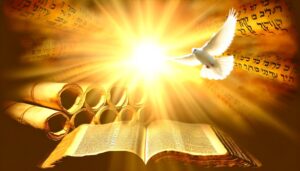Meaning Of Moon In The Bible: Divine Guidance
In the Bible, the moon is a multifaceted symbol reflecting divine order, timekeeping, and spiritual renewal. Genesis 1:16 describes it as a ‘lesser light‘ that governs the night, emphasizing God’s sovereignty in creation.
Its lunar cycles, significant in the Hebrew calendar, mark religious observances such as Passover and Sukkot (Psalm 104:19). The moon also features prominently in prophetic visions, symbolizing pivotal events in God’s salvific plan, as seen in Joel 2:31 and Revelation 6:12.
Furthermore, the moon’s phases metaphorically illustrate continuous spiritual transformation and divine constancy. To explore the deeper layers of its significance, there’s much more to examine.
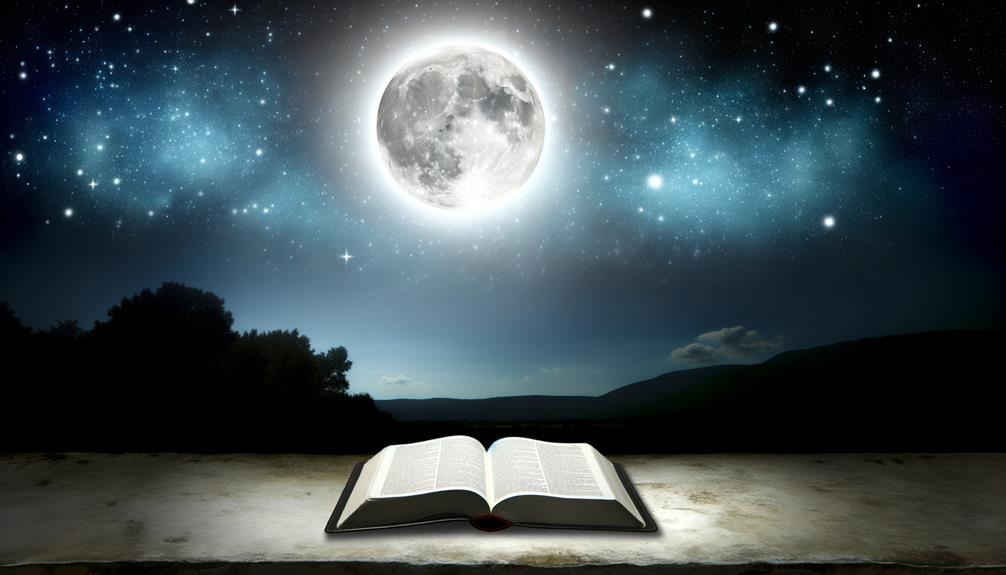
Meaning of Moon in the Bible: Symbolism, Prophecy, and Spiritual Significance
| Aspect | Description |
|---|---|
| Definition | The moon is the lesser light created by God to rule the night (Genesis 1:16). |
| Biblical Role | Used to mark times, seasons, and signs; often tied to prophecy. |
| Symbolism | Reflection, guidance in darkness, change, and divine timing. |
| Key Scripture | Psalm 104:19 – “He appointed the moon for seasons…” |
| Spiritual Insight | Symbolizes God’s order, His signs in the heavens, and spiritual reflection. |
Creation and the Moon

How does the moon’s creation, as described in the Bible, reflect the theological significance and divine order within the cosmos?
The moon’s creation is detailed in Genesis 1:16, where it is described as a ‘lesser light to govern the night.’ This scriptural passage underscores the moon’s purpose within God’s orchestrated universe, symbolizing divine order and intentionality.
Theologically, the moon serves as a demonstration of God’s sovereignty, acting in harmony with the sun to mark time and seasons. Historically, this celestial body represented constancy and reliability, attributes reflecting God’s enduring presence.
Moon as a Timekeeper

The moon’s role as a celestial timekeeper is intricately woven into biblical narratives, serving as a divine instrument for demarcating days, months, and seasons. The lunar cycle, with its phases, provides a natural calendar system referenced in scriptures such as Psalm 104:19, “He made the moon to mark the seasons.” This theological insight reveals God’s intention in creation for order and rhythm.
Historically, the Hebrew calendar relies on lunar months, underscoring the moon’s significance in religious observances and festivals. Scriptural analysis further recognizes the moon’s function in the timing of holy days, such as Passover and Sukkot, as outlined in Leviticus.
| Scripture | Function | Significance |
|---|---|---|
| Psalm 104:19 | Marks Seasons | Divine order in creation |
| Hebrew Calendar | Lunar Months | Foundation for religious observances |
| Leviticus | Timing of Holy Days | Synchronization with lunar cycles |
Moon in Prophecy
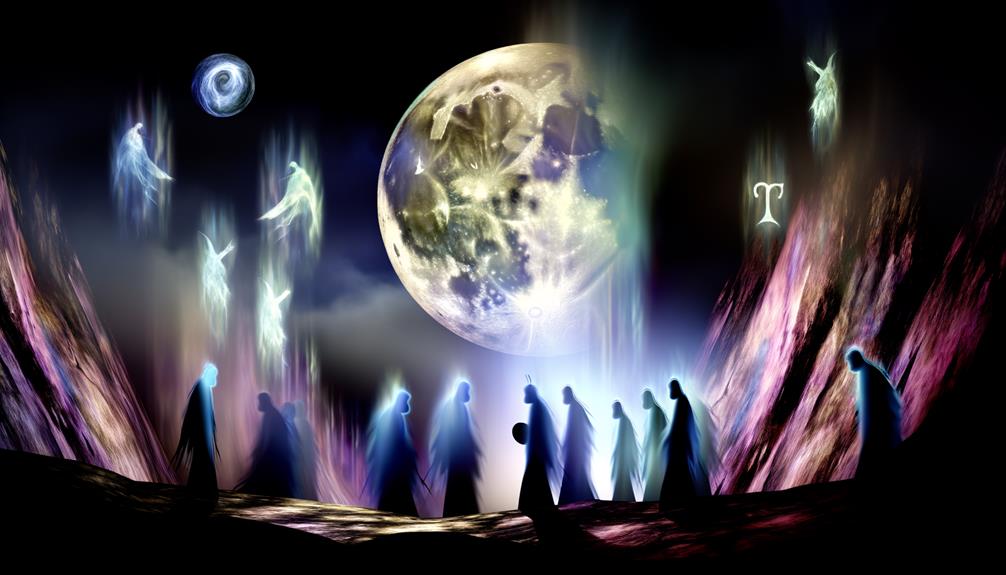
In the domain of biblical prophecy, the moon frequently serves as a potent symbol, often representing significant divine interventions and eschatological events.
Historical accounts in scripture highlight lunar occurrences, such as blood moons, as harbingers of pivotal moments in salvation history.
Analysis of prophetic texts, including Joel 2:31 and Revelation 6:12, reveals the moon’s role in signaling the unfolding of God’s ultimate plan for humanity.
Symbolism in Biblical Prophecy
Throughout biblical prophecy, the moon often serves as a potent symbol of significant eschatological events and divine intervention.
The prophetic literature, such as Joel 2:31, foresees the moon turning to blood as a precursor to the ‘great and terrible day of the Lord.’ This imagery symbolizes impending judgment and divine upheaval.
Historical context reveals that such celestial signs were understood by ancient societies as manifestations of divine will.
Theologically, the moon’s transformation underscores the transient nature of earthly kingdoms and the supreme authority of God.
Scriptural analysis also highlights the moon’s role in prophetic visions, such as in Revelation 6:12, where it signifies cosmic disturbances heralding the end times, emphasizing the urgency of spiritual preparedness.
Lunar Events and Signs
Examining lunar events and signs within biblical prophecy reveals the moon as a critical harbinger of divine actions, often signaling pivotal moments in sacred history. Scriptural references to the moon frequently appear in eschatological contexts, underscoring its prophetic significance.
For instance, Joel 2:31 and Revelation 6:12 speak of the moon turning to blood, symbolizing cataclysmic events and divine judgment. Historically, lunar phenomena were interpreted as signs of God’s sovereign intervention in human affairs.
| Biblical Reference | Lunar Event |
|---|---|
| Joel 2:31 | Moon turns to blood |
| Revelation 6:12 | Moon becomes like blood |
| Matthew 24:29 | Moon does not give light |
| Acts 2:20 | Moon turns to blood |
These passages collectively emphasize the moon’s role in heralding transformative divine acts.
Symbol of Change
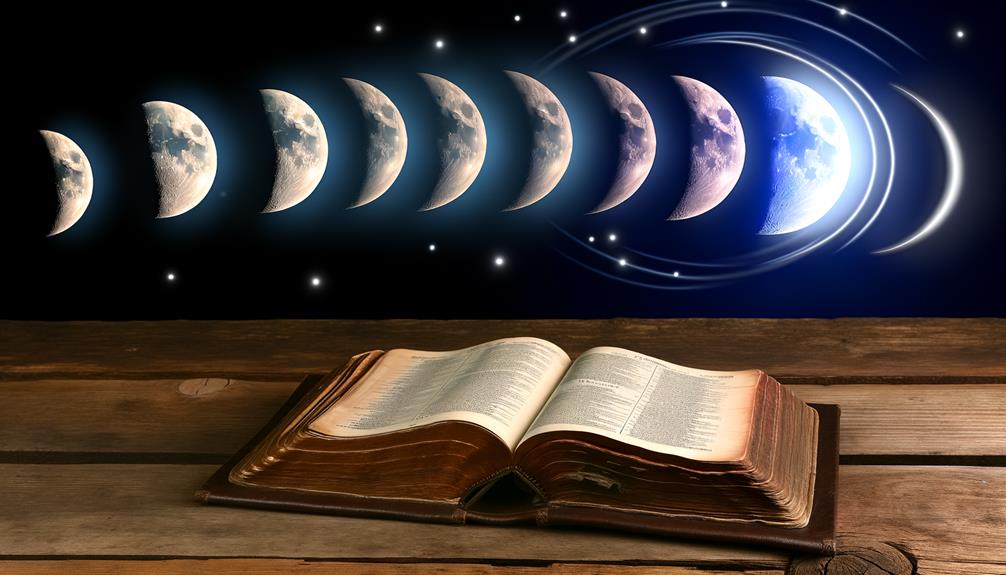
The moon in biblical scripture often symbolizes change, reflecting the natural cycles and transformation inherent in creation.
Its phases, from new moon to full moon, serve as a metaphor for spiritual renewal and the ongoing process of sanctification in a believer’s life.
This symbolism is evident in various passages, such as Psalm 89:37, where the moon is described as a faithful witness in the sky, illustrating God’s unchanging nature amidst life’s continual changes.
Cycles and Transformation
In biblical literature, the moon frequently symbolizes cycles and transformation, reflecting the natural rhythms and divine order established by God. The phases of the moon illustrate the cyclical nature of life, echoing themes of renewal and divine constancy. Scripturally, the moon’s phases often correspond to significant religious observances, emphasizing periodic reflection and adherence to divine statutes.
| Scripture Reference | Event/Phase | Symbolic Meaning |
|---|---|---|
| Genesis 1:14-16 | Creation | Divine order |
| Psalm 104:19 | New Moon | Timekeeping/Restoration |
| Numbers 10:10 | Festival Cycles | Worship and remembrance |
| Revelation 12:1 | Woman/Moon | God’s sovereignty |
Historically, the moon’s consistent cycles provided an essential calendar for ancient Israel, embedding spiritual rhythms into daily life. This celestial body therefore serves as a profound reminder of God’s unchanging nature amidst human changeability.
Spiritual Renewal
Recognizing the moon’s role in marking sacred times and cycles allows us to explore its deeper association with spiritual renewal and transformation throughout biblical narratives.
The lunar cycle’s waxing and waning symbolize the dynamic process of spiritual growth and rejuvenation. In Psalm 104:19, the moon’s phases are linked to seasonal changes, reminding believers of God’s sovereignty over time and creation.
Additionally, the New Moon festivals in Numbers 10:10 and Isaiah 66:23 emphasize renewal and restoration, inviting worshippers to reflect on their spiritual journey. This cyclical pattern mirrors the believer’s need for periodic introspection and repentance, fostering a continuous process of spiritual renewal.
Consequently, the moon serves as a profound symbol of divine grace and perpetual transformation in the biblical tradition.
Moon and Festivals
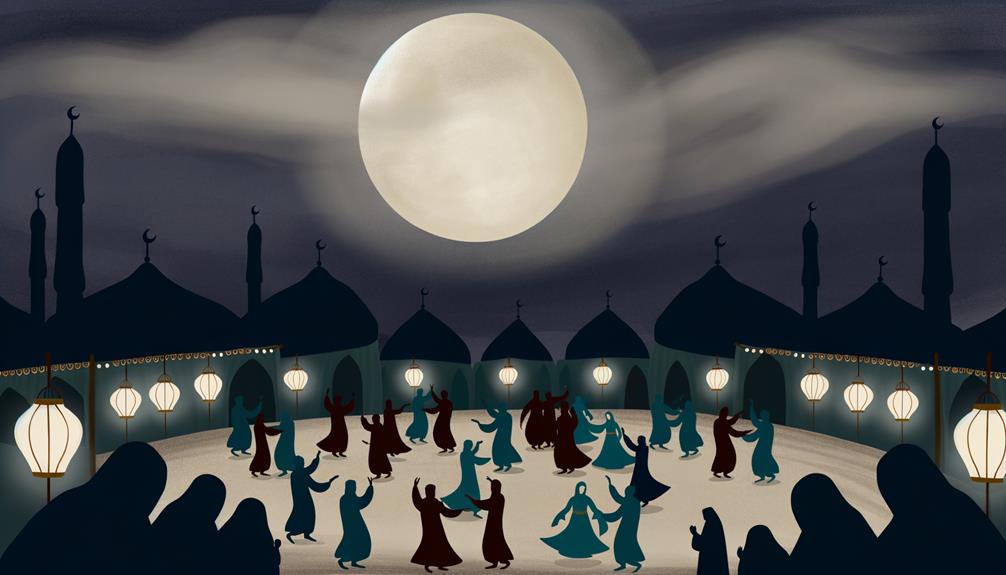
Central to the rhythm of biblical observances, the moon plays an essential role in the timing and celebration of key festivals in the Hebrew calendar.
Scriptural mandates, such as in Leviticus 23, outline specific lunar phases to mark feasts like Passover and Sukkot, aligning them with the new or full moon. This lunar-based calendar reflects a divine order, integrating natural cycles into worship practices.
Historically, the new moon signaled the beginning of the month, necessitating communal offerings as stated in Numbers 28:11-15.
Theologically, the moon’s phases symbolize renewal and divine providence, guiding Israel in both agricultural and spiritual seasons.
Consequently, the moon serves as a celestial instrument, harmonizing earthly celebrations with heavenly rhythms as ordained in the Scriptures.
Moon in Psalms

The Psalms frequently depict the moon as a witness to God’s enduring faithfulness and the constancy of His creation. Psalm 89:37 states, ‘It shall be established forever like the moon, even like the faithful witness in the sky.’ This verse underscores the moon’s role as a symbol of God’s unchanging covenant with His people.
Historically, the moon’s regular phases would have been a powerful image of reliability and order in the ancient Near Eastern context. Theologically, it serves as a celestial sign of God’s perpetual governance over creation.
In Psalm 104:19, the moon marks the seasons, reinforcing it as a divine instrument in the cosmic order. Consequently, the Psalms use the moon to reflect God’s steadfast presence and meticulous design.
Moon in Revelation

Building on the Psalms’ portrayal of the moon as a symbol of divine reliability, the Book of Revelation employs lunar imagery to signify pivotal eschatological events and divine judgment.
The moon’s transformation in Revelation serves as a harbinger of cosmic upheaval and divine intervention. Importantly, Revelation uses the moon to underscore the severity of God’s impending judgment and the ultimate triumph of divine justice.
Key instances include:
- Revelation 6:12: The moon turns blood-red, symbolizing catastrophic events and divine wrath.
- Revelation 12:1: The woman clothed with the sun, with the moon under her feet, signifies the birth of the Messiah and the struggle between good and evil.
- Revelation 21:23: The absence of the moon in the New Jerusalem highlights God’s eternal light eclipsing all other luminaries.
God’s Covenant Sign

In the context of God’s covenantal relationship with humanity, the moon serves as a symbolic marker of divine promises, often reflecting the unchanging nature of God’s word.
Historically, lunar cycles were integral to the Hebrew calendar, signifying appointed times and sacred festivals as outlined in scriptures such as Psalm 104:19.
This celestial body consequently not only illuminates the night but also underscores the fulfillment of God’s promises throughout biblical narrative.
Symbolic Lunar Significance
Throughout scripture, the moon frequently emerges as a potent emblem of God’s enduring covenant with humanity. Its cyclical nature symbolizes renewal and divine faithfulness. The moon’s role in biblical texts can be understood through various lenses:
- Theological Insight: The moon’s phases reflect the perpetual renewal inherent in God’s promises, illustrating His steadfastness and unchanging nature.
- Historical Context: In ancient Israel, lunar cycles governed religious festivals, marking sacred times and reinforcing the rhythm of divine-human interaction.
- Scriptural Analysis: Passages like Psalm 89:37 (‘It will be established forever like the moon, the faithful witness in the sky’) underscore the moon as a celestial sign of God’s unwavering covenant.
This symbolic significance offers a profound reflection on divine fidelity across generations.
Biblical Promises Fulfilled
The moon, as a celestial marker, not only illuminates the night sky but also serves as proof of the fulfillment of God’s promises throughout biblical history.
In Genesis 1:14-18, the moon is established to mark seasons, days, and years, reflecting God’s covenantal faithfulness. Similarly, in Psalm 89:37, the moon is described as a faithful witness in the sky, symbolizing the enduring nature of God’s covenant with David.
The moon’s consistent presence underscores divine reliability, reinforcing promises of steadfast love and unbroken commitment. By examining these scriptures, we perceive the moon as a divine symbol, affirming God’s unwavering fidelity to His covenants and inviting believers to trust in His perpetual promises.
Moon’s Spiritual Symbolism

Within the biblical narrative, the moon often symbolizes divine guidance and the cyclical nature of spiritual renewal. The moon’s predictable phases serve as a metaphor for the consistent presence and faithfulness of God. This celestial body’s role in marking time emphasizes the rhythm of spiritual practices and festivals. The moon’s light in the darkness can be seen as representing God’s illumination in human lives.
Here are three key aspects of the moon’s spiritual symbolism in the Bible:
- Divine Guidance: The moonlight guides travelers by night, akin to God’s guidance (Psalm 121:6).
- Cyclical Renewal: Monthly moon phases symbolize renewal, reflecting spiritual rejuvenation (Psalm 104:19).
- Illumination in Darkness: The moon’s light penetrates darkness, symbolizing God’s word bringing clarity and hope (Genesis 1:16).
Interpretations by Scholars
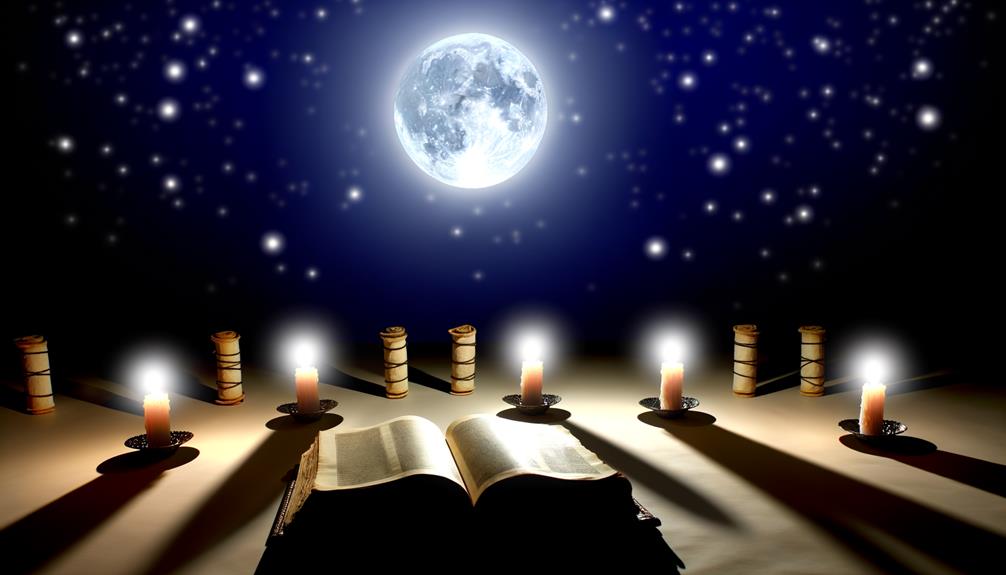
Building upon the spiritual symbolism of the moon, scholars have extensively analyzed its biblical representations to uncover deeper theological insights and historical contexts.
The moon often signifies God’s provision and the passage of time, as seen in Psalm 104:19, where it marks seasons.
In prophetic literature, such as in Joel 2:31, the moon turning to blood symbolizes apocalyptic events, suggesting divine judgment and eschatological fulfillment.
Scholars also consider the moon’s phases as metaphors for human existence and spiritual growth, reflecting cycles of renewal and transformation.
Conclusion
The moon in biblical texts serves as a celestial tapestry woven with theological, historical, and prophetic threads. It operates as a divine chronometer, marking sacred times and seasons, while also symbolizing change and renewal.
From the Genesis creation narrative to apocalyptic visions in Revelation, the moon’s multifaceted roles underscore its significance.
Interpreted through the lens of scripture and scholarly exegesis, the moon emerges as a luminary of divine purpose and spiritual symbolism, reflecting God’s covenantal faithfulness.


